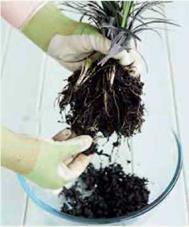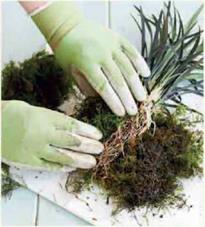Meaning “moss” (koke) and “ball” (dama), kokedama is a Japanese art form that offers a whole new way of displaying house plants. It’s intriguing, tranquil, and thoroughly enjoyable to put together.
![]() TIME IT RIGHT Plants should last 1-2 years and can be kept small by pruning. If roots start to show through, it’s time to repot. Almost any plants can be grown but remember some will die off or go dormant in winter, while evergreens provide year-round interest.
TIME IT RIGHT Plants should last 1-2 years and can be kept small by pruning. If roots start to show through, it’s time to repot. Almost any plants can be grown but remember some will die off or go dormant in winter, while evergreens provide year-round interest.
PLANT LIST
carpet moss
Davallia humata tyermanii ‘Bunny’ Erigeron karvinskianus Hosta ‘Blue Mouse Ears’
Miscanthus sinensis ‘Gold Bar’ Nephrolepis exaltata Ophiopogon nigrescens Platycerium bifurcatum Rhodanthemum ‘African Eyes’ sphagnum moss (if dried, soak for at least 1 hour first and squeeze out excess water before using)
|
|
|
I |
Take plants out of their pots and remove as much soil as you can over a bowl without damaging the root systems. The aim is to keep the root ball as small as possible, though plants with fibrous roots (such as ferns) will need to keep some soil mix.
|
|
|
|
|
2 |
Take a small amount of sphagnum moss and make a “moss wrap” by rolling the plant’s roots in it. Set aside in a shady place and make the ball.
чЛ—Project Steps
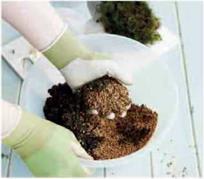


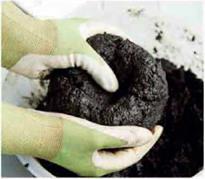
|
3 |
In a bowl, mix together 70% peat-like potting mix with 30% akadama soil.
|
4 |
Now add water a little at a time and shape into a wet clay-like ball that holds together but is porous, and is large enough to take your plant’s root ball.
|
3 |
Make a space in the center of the ball with your thumbs to take the plant’s moss-covered root ball. Insert the root ball and mold back into a ball or teardrop shape.
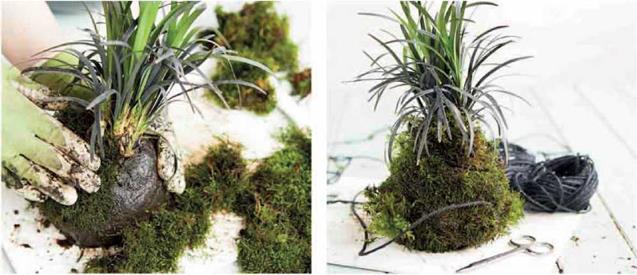
|
6 |
Start to cover the outside of the ball with carpet moss; both this and sphagnum moss are available from florists and floral suppliers. Dampen the moss with a water mister before using.
|
7 |
Take your string or twine and wrap it around the moss ball so that everything is held securely in place. Leave two long strands at either side, or one central strand, for hanging. Then simply hang your kokedama on a secure hook and enjoy.
|

